
Electronic toys: What’s hot in 2023!
High-tech for youngster and grown-ups
By Peter Pernsteiner
Spielwarenmesse 2023 made it impressively clear that electronics and the smartphone have become key components in many products. This starts with the classic race track for competitions between up to six drivers on a two-lane racetrack and ends with a sophisticated combination of real model cars and virtual reality on a display.
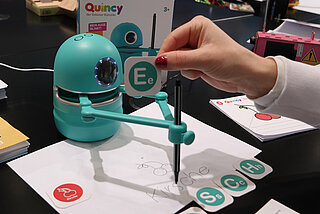
Modern electronic learning support is now available for children as young as just 3 years of age. With the Quincy robot, Kaiserberg Trading wants to playfully help children learn how to write, spell, calculate and draw by means of a child-friendly drawing computer. It has a motorised drawing arm into which, for example, a felt-tip pen can be clamped. The camera eye of the small battery-operated device captures QR codes from little cardboard cards with letters or pictures of, for example, an animal or fruit on them. The computer then draws the fruit on the paper and a synthesized voice asks the child to spell out the word. Then the child holds up letter after letter in front of the camera. If the letter is the correct one, the robot is happy and draws this letter on the paper. Finally, the sheet of paper with the drawing can also be coloured in. To expand its capabilities, Quincy has a slot for a microSD memory card on its back.
To YouTube: Interview - Drawing robot Quincy teaches children to write and do maths
Experiments for young scientists
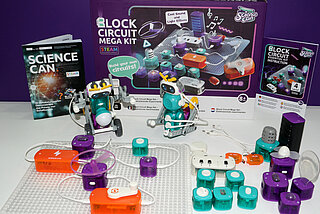
Older children are able to enter the world of science kits. Block Circuit from Topbright Toys, for example, helps children aged 8 and over to understand the basics of electrical and electronic circuits. Actually, this construction kit was supposed to be presented at Spielwarenmesse 2022, which, as is well known, was cancelled due to the pandemic. That’s why Block Circuit has now been presented in all the more detail. The building blocks are placed on a studded base plate and connected to each other via USB-C cables. This enables users to explore the mode of operation of an RGB light, the volume control of a mini piano or the speed control of a motor. The Block Robots robot construction kit, which will be available in the autumn of 2023, was presented as a trade fair innovation. It also contains, among other things, a lot of plug-in elements and gears which can be used to assemble motorised toy robots.
To YouTube: Interview - Block Robots / Circuit experimental kits from Topbright
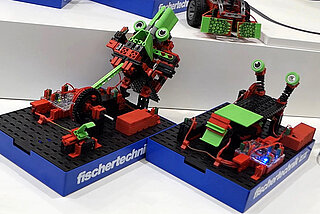
For many years now, fischertechnik has been offering compact control units that can be individually programmed and used with the mechanical construction kits with motor units that are also available for purchase. Since the autumn of 2022, the TXT 4.0 controller with a touch screen, eight switching outputs or four motor outputs as well as three outputs for servo motors has been available. They can be individually logically combined with twelve inputs. In addition, a USB camera can be connected to the controller; it records movements, colours and barcodes, for example, and uses them for control commands. The new Smart Robots starter set provides an easier introduction to the world of the smart home. The set includes a small controller module with four inputs and two motor outputs. With this, a simple alarm system, a temperature control with a fan, a ball-throwing catapult or a motorised vehicle with obstacle detection and path correction, for example, can all be programmed with the aid of a smartphone and Bluetooth.
To YouTube: Interview - Fischertechnik crazy reactions, funfair, smart robots, TXT 4.0
Robots encroaching into more than just children’s bedrooms
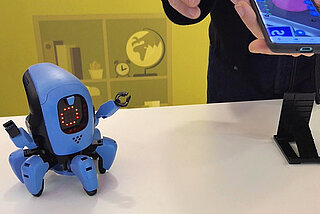
The topic of artificial intelligence (AI) will become ubiquitous in the near future and is, even now, encroaching children’s bedrooms. With the Miika AI experiment kit, Franckh-Kosmos wants to teach children from the age of 10 the basics in a playful way, using a six-legged electrically driven walking robot made from more than 100 individual parts. With the aid of a free smartphone app, the child can then train the robot to respond to control commands communicated by hand and body gestures. The robot can also be controlled using voice commands. Miika can walk forwards and backwards and turn its upper body clockwise and anti-clockwise. A richly illustrated workbook with 68 A5-sized pages includes child-friendly building instructions, and teaches the basics of AI in a very easy-to-understand way.
To YouTube: Interview - Miika AI experiment kit - Kosmos robot with gesture control
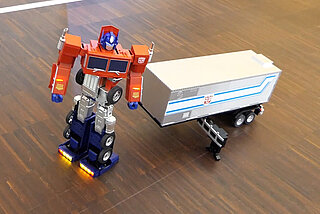
Just what is technologically possible in the field of robots today was demonstrated in a very impressive way by Robosen in Nuremberg. The 48 cm high programmable walking robot Optimus Prime transforms into a 36 cm long truck in just nine seconds via a smartphone voice command. The truck can then be easily controlled remotely using a smartphone and two thumbs and can, if required, be transformed back into a robot while still on the move... just like in the movies! So that it can do that, the 2.8-kilogram toy for adults contains no less than 27 servo motors and 60 microchips. The robot, which costs a shade under 1000 euros, can be taught almost any movement. Anyone wanting even more fun can buy a 56 cm long semi-trailer to go with it. With the help of 18 servo motors, it transforms into a kind of support base for Optimus Prime, just like in the movies, too!
To YouTube: Interview - Robosen Transformers robot with 27 servos - Optimus Prime
Fun with cars – real and virtual
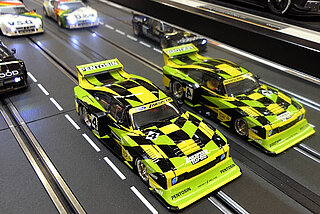
However, not everyone actually wants a slot car that transforms into something else – there’s also much simpler fun to be had. For 60 years now, young and old alike have been enthusiastic about Carrera slot car racing tracks. So it’s no wonder that Carrera Toys dedicated itself to this particular anniversary at this year’s Spielwarenmesse. The highlight here was a large starter set in a 1960s packaging look. The Retro Grand Prix set includes three racing cars on a scale of 1:32 as well as 9.3 metres of racetrack! Despite the retro design, up to six cars and drivers can compete against each other at the same time, thanks to new digital technology. That’s why the set includes a double-lane change unit which can easily triggered be with an index finger while using the speed controller. One of the three cars included in the anniversary set is even a new design – the Lancia Beta Turbo Montecarlo. Another useful novelty is a track-cleaning vehicle that looks like a tow truck and the VW Bus T2b might appeal to many as a cult vehicle. In the slot car tracks, there is a 102 cm long chicane as a novelty, which is suitable for vehicles in a scale of 1:32 as well as in 1:24. Finally, for children who often have to do things on their own, there is the Carrera Go Challenge starter set with a single-lane track in a scale of 1:43, where you race against the clock in particular.
To YouTube: Interview - 60 years of Carrera racetrack - Slotcar News 2023
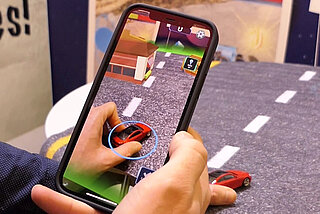
At the Spielwarenmesse, the boundaries between the real toy car world and virtual reality also merged to some extent. Augmented Robotics, for example, showed how a classic toy car in Matchbox style can be combined with a virtual world in a smartphone app. With the free augmented reality (AR) app called "Zombie Crasher", users nudge a small sliding toy car on the table or on the floor with a tap of their fingers to hit virtual zombies and so collect points. The car is captured with the aid of the smartphone camera and supplemented with virtual buildings, obstacles and walking robots that can only be seen on the display. In another scenario, the company presented an AR app developed for Revell that can be used with a remote-control vehicle that is also enhanced with a virtual environment on the smartphone.
To YouTube: Interview - Toy car AR app - real model car in augmented reality
Smartphone supports card game
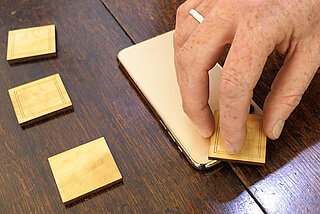
Even classic board or card games are increasingly being enhanced by smartphones. For example, at the PressPreview of the Spielwarenmesse 2023, the start-up company Oberlin & Rennertz showed an ingenious way to extend its memory training game Klang2 (pronounced Klang (German for sound) to the power of 2). In this game with 20 square wooden tiles, two matching tiles have to be found and uncovered, just as in the classic memory game. However, the game pieces have no printing on them – neither on the front nor on the back. Instead, they contain an NFC chip for near-field communication with a smartphone. To "uncover" them, they have to be held up to the smartphone and the app emits the corresponding sounds or melodies. In the game, for example, players have to find matching city and country names, birdsongs, melodies by the same composer or proverb halves. Klang2 comes in a beginner’s version with pieces made of bookbinding material or precious tonewoods, i.e. woods used in making violins, for example. The start-up company also presented a novel product: a game creator which customers can use to develop their own acoustic games that they can then disseminate in an online community.
To YouTube: Interview - Memory training game Klangquadrat - Klang2 app with NFC chips
Interested in hearing more about Electronic Toys?
Further information on the participating Electronic Toys product group is available on Spielwarenmesse Digital. Learn more about the innovations.
About the author
Peter Pernsteiner (graduate engineer and freelance journalist) discovered his love of technical journalism during his electrical engineering studies and soon after found himself in the editorial department of a large ITC trade journal. Since 1994, he has been a freelance journalist, writing in particular on technology topics – including for magazines in the model railway sector. In 2016, he also launched a YouTube channel for technology reports, which has since attracted worldwide attention.



![[Translate to Englisch:] Tunnelbohrmaschine in 1:87 von Faller auf der Spielwarenmesse. (Foto: Pernsteiner)](/fileadmin/_processed_/6/c/csm_20230329_Teaser_35537af20a.jpg)
